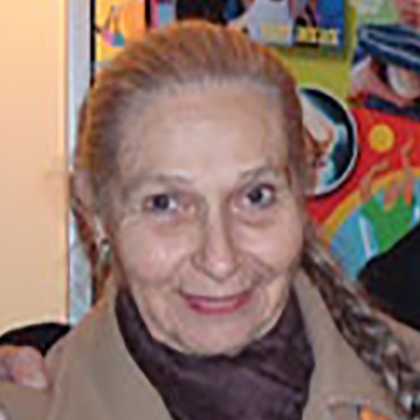- Home
- Rokdim Nirkoda 115
- 102 Years of Dance
By Raya Spivak, Pnina Klein
When talking about the generation that founded Israeli folk dance, the first name that comes up is, of course, Gurit Kadman. However, the person who put Gurit Kadman’s vision into practice and, for decades expanded, nurtured and preserved this vision, called “The folk dance movement in Israel”, was Tirza Hodes.
Tirza was born in 1922 in in Dusseldorf, Germany and passed away on April 11, 2024. The notice of her death reads, “Seven days and many verbs.” Indeed, she reached an advanced age and more than that, she was a very active individual until the end of her life. All this in a field which was seen as supremely valuable. She had a desire to nurture, preserve and promote the folk dances that symbolize the Land of Israel and the State of Israel and to lead a movement for those who shared her vision. Tirza saw in Israeli folk dance the elements that would create a meaningful and important national language and identity.
Tirza, was a “good girl” from a wealthy Zionist home. She descended from an extensive lineage of rabbis, reaching back to Rashi (Rabbi Shlomo Yitzchaki).
In her youth in Germany, Tirza trained in track and field, and was the “Maccabi” junior champion in the 100-meter race. She was a member of the Blau Weiss (Blue and White) movement for Jewish youth, where she learned Hebrew songs and met young people like herself.
While still a teenager, she experienced Kristallnacht, where she lost her parents in the pogroms perpetrated by the Nazis. Her brother saved her and took care of her. After Kristallnacht, she began a journey of escape and that ended with her arrival in Israel in 1939 as part of the Youth Aliyah. She was sent to the workers’ farm in Rishon LeZion which absorbed Jewish youth from the Holocaust.
When she heard about the establishment Hatzor, the Hashomer Hatzair kibbutz, Tirza joined as a member. The young kibbutz members wanted to create a new tradition for the Jewish holidays that would fit in with the values of the kibbutz and the country. Tirza took the initiative, formed a dance troupe and prepared dance performances for each holiday’s celebration at Hatzor.
Soon the kibbutz movement heard about her dance works and contacted another pioneer, Gert Kaufman, later known as Gurit Kadman.
Gurit invited Tirza to work with her to promote the idea of establishing a movement of Israeli folk dance. Gurit dreamed of expressing this vision through a mass movement that would develop and nurture a national cultural vision; a vision that would see its best expression through a type of folk dance that would draw on its pioneering roots and Jewish traditions, thus expressing the Jewish people’s renewal in the Land of Israel.
The plan was to spread this movement to working settlements and various urban places, such as the Hapoel Sports Associations, Maccabi and others, so that dance movement would reach everyone.
In the early 1950s, Tirza began to direct the “Mador Le’Rikudei Am” (the Folk Dance Section) of the Histadrut. She initiated and established ulpanim (courses) for training folk dance instructors in Tel Aviv, Jerusalem, Haifa, Afula and Kiryat Shmona, and organized hishtalmuyot (workshops) for instructors. She held seminars and hishtalmuyot for both holiday dance and folk dance.
She led and danced with young people and older adults at Purim parties and at dance sessions in Israel and around the world, always with a sense of pride and national mission. She brought this unique vision to the United States, Europe, South Africa, and even Iran.
Throughout her life, Tirza knew how to respect the role assigned to her by Gurit, to preserve and nurture the idea of a mass cultural movement, and to develop teachers and leaders in such a way that the subject and purpose would be close to their hearts.
Throughout her years, Tirtza ensured that Israeli folk dance would remain faithful to the idea of being a language with a national cultural value. It has remained a unique language that expresses the land and its people. Gurit’s vision was always her guiding principle.
In her role as Director of the Folk Dance Section of the Histadrut, Tirtza approached various bodies to recognize and integrate folk dance into every cultural event and to encourage them to see it as part of our moral and representative culture. She appealed to the Foreign Ministry, the Jewish Agency, the Ministry of Education, the Working Settlements, municipalities, local councils, sports associations, and other cultural and government institutions to forge ties to folk dance, to integrate it into their activities, and to recognize folk dance as a national and educational mission.
Representative dance troupes were established in municipalities and local councils. They became an integral part of national dance conferences and festivals, starting with the first Dalia Festival in 1944, continuing at four more festivals at Kibbutz Dalia. In future years, they continued to perform at the Tzemach Festival on the Sea of Galilee, and the Karmiel Dance Festival which is held to this day with great pomp and splendor.
It is important to note the establishment of “HaLehaka HaMerkazit” – Israel’s first dance troupe led by the legendary Yonatan Karmon who went further in the field, established the Karmiel Festival and continued to contribute to other areas in the field of folk dance throughout his life.
Tirza saw a connection between a dance and the song accompanying it. The combination of the two, the melody and dance, as well as the lyrics of the song, were in her eyes a very important combination of values.
Eight years ago, in 2016, Tirza celebrated her 94th birthday, and from this advanced age until the age of 98 she continued to travel and teach in Jewish communities in Germany, engaging vacationers there with morning gymnastics, singing and, of course, folk dancing, with an emphasis on the Jewish holidays and Jewish tradition, as she had from the beginning of her long career.
About the seminars in Germany, Lucy Maman writes:
I first met Tirza in 1978, at Seminar HaKibbutzim, auditioning for Lehakat Karmon. Later, we reconnected after many years in my work as a choreographer for dance companies and as a movement instructor in the ulpan for folk dance instructors.
In 2009, I was privileged to join Tirza in her training courses in Germany, after she made it clear to me that most of the community members at the seminar were Russian speakers, immigrants from the former Soviet Union. As a native of Russia, I was touched by the need to connect them to Israeliness and culture in Israel.
The first seminar I taught with her was interesting and fascinating. The way she managed it was greatly appreciated from the meticulous attention to the content to the various lecturers who brought Israeli culture. At the end of the seminar, she asked me to continue working with her, which I did in all her travels until 2020 when COVID-19 hit.
For the past two years, I traveled without her, and it was very different. She was sorely missed, by me and everyone.
It was important for Tirza to promote and deepen professionalism in the seminars and to preserve the heritage. It was with this intent that we made sure to choose quality dances and songs. Together we thought about training local instructors, enriching them with knowledge and giving them new tools so that they could establish and instruct folk dance and lehakot (performing troupes) independently in each of the communities in Germany. Thus, a festival was established, grew and developed, in which groups from 22 communities in Germany present their accomplishments.
Each seminar was dedicated to a carefully chosen topic around which we wove dances, song study and lectures, in order to delve more deeply into the topic. We held separate seminars for beginners and advanced students. The advanced instructors who were trained, worked with Tirza and later helped her in various other seminars.
Each time, it was very thrilling to see how excited everyone, from veterans to beginners, were when they met Tirza. She was a figure admired by all and she earned a lot of respect from those around her. Her discipline, organization and structure were exemplary, and she was a paradigm to everyone.
Tirza always came with a suitcase full of gifts for all of the employees. She was modest but was quite demanding, first of all, of herself. She had a sense of humor and loved to tell jokes about “Yekim” (German Jews).
Tirza’s huge contribution and dedication have been invaluable. She established a magnificent cultural enterprise. The Israeli dance world in Israel and internationally has cherished, appreciated and admired her. Tirza was the one and only. I had the great privilege of working alongside her for 15 years in Germany. I loved her, and she will be in my heart forever.
Over the years, Tirza has received great recognition for her work including earning the Israel Art Association Award for Lifetime Achievement.
In 2009, as part of the Karmiel Dance Festival, Tirza Hodes was awarded the title of “Yakirat Irgun HaMadrichim Le’Rikudei Am (Honorary Member of the Association of Folk Dance Instructors)”.
Tirza was privileged to see and enjoy the fruits of her labor. She lived to see the impact she had on the establishment a magnificent cultural enterprise.
Yiyhe zichra baruch – May her memory be blessed.









Comments
התראות